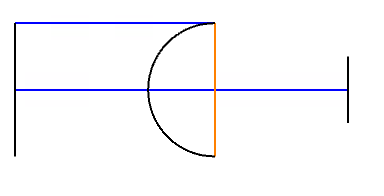Hello, this is my first post! I am hoping someone can help me understand what I might be doing wrong. In my first attempt, I tried to create a plano-convex (pcx) lens with an entrance pupil diameter (EPD) of 5 mm and an f-number of 1.0.
I specified an EPD aperture type and then set its value to 5 mm. I then set the semi-diameters of the first and second surfaces to half the EPD value, and the thickness of the third surface to 5 mm. My thought being that this will give me an f/1 system (see prescription below).

However, from the image below, you can see that the marginal ray is being “clipped.”

I verified this by running a single ray trace and sure enough the Real Ray Trace Data for surface 3 says, “Ray terminated, TIR at surface 3.” Also, the Image Space F/#, Paraxial Working F/#, and the Working F/# all report 0.95893. I tried to increase the radius value, in very small increments, and did notice the F/# value increasing slightly, but it never goes above ~0.96. Is there something wrong in my process? I feel like there is something fundamental that I am missing here. Anyways, I look forward to any help.
-Cheers!







